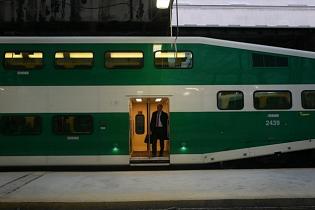Meet Toronto’s Reverse Commuters
Toronto resident Haicheng Mao dreads the days when the Jays are playing. Although it sounds like he’s not a supporter of the team, the reality is he just knows that weekday game night means he’ll be stuck in traffic driving back home from work.
Haicheng Mao is part of a growing community of “reverse commuters” in Toronto. Mr. Mao makes the drive from City Place to Burlington 4 times a week.
“On the worst days it’s pretty much a parking lot,” said the 24-year-old of the Gardiner Expressway. “Literally, I sit in traffic staring at my building wondering what my dog’s doing.”
Whenever there’s a sports event in Toronto, it messes with Mao’s commute. While most Toronto drivers are heading in one direction, he is going the opposite way. By 5 pm, when most people are leaving the city, he is leaving his job at Burlington to his downtown apartment in City Place. Mao is part of a growing community of “reverse commuters” in Toronto.
As part of a sporadic series, The Star is examining some of the old stereotypes that still stick to the megacity, the urban/suburban divide, and some of the surprising ways Toronto remains united and divided even after 20 years of amalgamation.
Even though they’re still a minority group, approximately 11% of people living in the older parts of Toronto usually work outside municipal lines. According to the 2016 census, they are commuting to Vaughan, Mississauga, and even beyond. They are breaking the stereotyped that every commuter is coming from the suburbs and heading downtown. This is also putting additional stress on a regional transit system that was designed to funnel people in the other direction.
The population of Toronto is more numerous than ever before sadly, downtown Toronto seems to be falling behind. Once upon a time, people use to migrate to the suburbs in order to economize. Today, you can find a hire in nearly every corner of downtown Toronto.
There are plenty of “reverse commuters” in Toronto. These individuals dwell within the previous metropolis however, they work outdoors at the current municipal boundaries. Data gotten from the 2016 census puts this number at 11% of the workforce.
A spokesperson for Metrolinx Anne Marie Aikins has however mentioned that the company is well aware of the rising number of reverse commuters and they are working to put up a service in both courses. “We’ve been progressively growing as a lot as we will,” she mentioned, naming all-day weekday service on the Barrie GO line as a current instance.
According to her, the plan is still going to be for all-day two-way GO practice service throughout the region. However, several obstacles need to be cleared such as wanting extra rail strains in some communities not to mention the enormous quantity of labor required.
Aikins also made mention that GO additionally wants to collaborate with a ride-share service. She had this to say about the partnership, “the idea is to make it accessible and inexpensive for purchasers so that they don’t have to make use of their automotive to get to stations.”
Comments
There are 0 comments on this post





